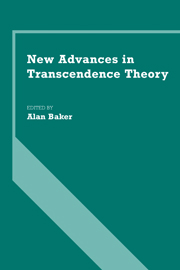Book contents
- Frontmatter
- Contents
- Preface
- Contributors
- 1 On effective approximations to cubic irrationals
- 2 Applications of measure theory and Hausdorff dimension to the theory of Diophantine approximation
- 3 Galois representations and transcendental numbers
- 4 Some new results on algebraic independence of E-functions
- 5 Algebraic values of hypergeometric functions
- 6 Some new applications of an inequality of Mason
- 7 Aspects of the Hilbert Nullstellensatz
- 8 On the irrationality of certain series: problems and results
- 9 S-unit equations and their applications
- 10 Decomposable form equations
- 11 On Gelfond's method
- 12 On effective bounds for certain linear forms
- 13 Automata and transcendence
- 14 The study of Diophantine equations over function fields
- 15 Linear relations on algebraic groups
- 16 Estimates for the number of zeros of certain functions
- 17 An application of the S-unit theorem to modular forms on Γ0(N)
- 18 Lower bounds for linear forms in logarithms
- 19 Reducibility of lacunary polynomials, IX
- 20 The number of solutions of Thue equations
- 21 On arithmetic properties of the values of E-functions
- 22 Some exponential Diophantine equations
- 23 Arithmetic specializations theory
- 24 On the transcendence methods of Gelfond and Schneider in several variables
- 25 A new approach to Baker's theorem on linear forms in logarithms III
- 26 Linear forms in logarithms in the p-adic case
14 - The study of Diophantine equations over function fields
Published online by Cambridge University Press: 05 January 2012
- Frontmatter
- Contents
- Preface
- Contributors
- 1 On effective approximations to cubic irrationals
- 2 Applications of measure theory and Hausdorff dimension to the theory of Diophantine approximation
- 3 Galois representations and transcendental numbers
- 4 Some new results on algebraic independence of E-functions
- 5 Algebraic values of hypergeometric functions
- 6 Some new applications of an inequality of Mason
- 7 Aspects of the Hilbert Nullstellensatz
- 8 On the irrationality of certain series: problems and results
- 9 S-unit equations and their applications
- 10 Decomposable form equations
- 11 On Gelfond's method
- 12 On effective bounds for certain linear forms
- 13 Automata and transcendence
- 14 The study of Diophantine equations over function fields
- 15 Linear relations on algebraic groups
- 16 Estimates for the number of zeros of certain functions
- 17 An application of the S-unit theorem to modular forms on Γ0(N)
- 18 Lower bounds for linear forms in logarithms
- 19 Reducibility of lacunary polynomials, IX
- 20 The number of solutions of Thue equations
- 21 On arithmetic properties of the values of E-functions
- 22 Some exponential Diophantine equations
- 23 Arithmetic specializations theory
- 24 On the transcendence methods of Gelfond and Schneider in several variables
- 25 A new approach to Baker's theorem on linear forms in logarithms III
- 26 Linear forms in logarithms in the p-adic case
Summary
Introduction
In recent years there has been important progress in the study of Diophantine equations over function fields. This has aroused increasing interest in the subject, and has led to the re-examination of some old results, as well as the realisation that there is now a wide variety of areas to which the subject is applicable. We shall spend a little time on the history and present state of the subject before proving a specific result concerning decomposable form equations. This result forms the completion of a series of works which attack several general classes of equations by means of an important inequality on solutions of the multivariate unit equation.
There are now three distinct analytical approaches to the study of Diophantine equations over function fields. The first is that of algebraic geometry, the second that of differential equations, and the third that of Diophantine approximation.
The celebrated theorem of Manin and Grauert established the analogue of Mordell's conjecture (now Faltings' theorem) for function fields, on the finiteness of the number of solutions of equations in two variables. This confirmed the great progress made in algebraic geometry since the Second World War. Grauert's approach was heavily dependent on esoteric algebraic geometry, and his work led to further advances in that subject by Shafarevitch and Paršin. Although the Manin-Grauert result was extremely general, for many years it was believed that their methods would not lead to effective bounds on the actual solutions of equations, nor would it allow the solutions themselves to be determined explicitly.
- Type
- Chapter
- Information
- New Advances in Transcendence Theory , pp. 229 - 247Publisher: Cambridge University PressPrint publication year: 1988
- 4
- Cited by



